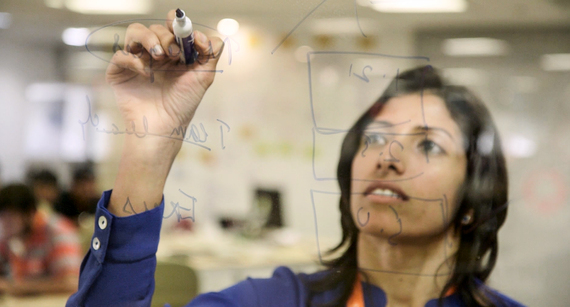In the past few decades, innovation has made a big impact in global development. Just look at Oral Rehydration Therapy - a simple mixture of sugar, salt, and water that treats diarrheal diseases like cholera. It has saved the lives of 50 million children in the last 30 years. That's roughly the population of Spain.
Breakthroughs can bend the curve on ending extreme poverty. But we need to let go of the myth that all it takes is a bright idea. Edison's famous quote that genius is "1% inspiration and 99% perspiration" is dead on. Getting an idea to scale is a long, hard slog.
When I ask entrepreneurs what holds them back, the most common answer is funding. This is especially true during what Monitor Deloitte calls the "Pioneer Gap" - that middle stage between pilot and scale. There is no question that funding is a challenge. At the same time, if you focus on getting the business fundamentals right, finding funding will be a lot easier. Here are three basics I think are critical, but often overlooked:
1. Vaccinate Yourself Against the "Field of Dreams" Syndrome
"If you build it, they will come" only works in the movies. For the rest of us, it takes a concerted effort to build user demand for a product or service. Even if an innovation can dramatically improve lives, the intended user might not see it that way. And, of course, it can't make an impact if people don't know about it.
This was even true for Oral Rehydration Therapy (ORT). Although ORT was discovered in the 1960s, it wasn't widely adopted until the 1980s. There were many reasons for this, but one of the most significant was that mothers didn't know why or how they should use it. In order to drive awareness, a local Bangladeshi NGO, BRAC, ran a massive door-to-door education campaign, teaching 12 million mothers in 75,000 villages how to make and use the solution. Because of their painstaking efforts, childhood deaths across Bangladesh fell by 80%.
Another example is Babajob, a platform that connects informal sector workers in India - like drivers, maids, and security guards - with better job opportunities. They found users through bus ads, radio, billboards, and even printed ads on tea cups. Still, despite strong uptake, they struggled to attract people with low literacy skills. So, with a grant from USAID, they created an Interactive Voice Response (IVR) platform to access their service with a basic mobile phone. More than 800,000 offline job seekers have joined Babajob through the IVR system, and it is growing rapidly.
2. Find a Path for Financial Sustainability Before You Scale
All good things must come to an end - and grant funding is no different. Perhaps the most important barrier to scaling social enterprises is a sustainable revenue stream that can fuel growth over the long term. That could mean government adoption of the product, revenue from user fees, or a hybrid.
For example, One Acre Fund helps smallholder farmers increase their productivity. It offers agricultural training, provides financing for farm inputs, and sells high-quality seed and fertilizer. Farmers pay for products and services plus an interest rate or service fee, which covered 78% of One Acre Fund's field costs in 2015. Last year, One Acre Fund served 305,000 farm families, who increased their profits by 55%. The organization's long-term goal is to reach full financial sustainability for their field operation.
3. If You Love It, Set It Free
Last, a hard truth: the visionaries who come up with breakthrough ideas are not always the best equipped to take them to scale. A recent Shell Foundation report on social enterprises found "the single largest cause of failure occurs when management teams lack the necessary business skills and competencies." We've also seen this in the private sector, with a Harvard Business School study finding founders facing a critical choice - to stay in control and potentially limit growth or to bring in the expertise needed to realize an idea's full potential. This could mean a tough choice of merging or partnering with a larger organization, bringing in experienced executives, or even hiring a CEO and stepping into a founder's role.
At USAID, we have seen the power of this self-awareness in action. Take the Odón device, a low-cost instrument that has the potential to be safer and easier to use than forceps to assist in obstructed births. The inventor - an Argentinian car mechanic - recognized that he didn't have the expertise to develop and manufacture it. Instead he licensed it to Becton, Dickinson and Company, a major medical device manufacturer that is developing and testing the device in collaboration with the World Health Organization and USAID's Saving Lives at Birth Grand Challenge. Odón told the manufacturer that it felt "like taking my child to university so it may grow and achieve what I have long dreamed."
Scaling an innovation is hard, but possible. For innovators, it requires perspiration, grit, and enough humility to know when you need help. For donors, it requires the discipline to focus on long-term sustainability. The stakes are high and it won't be easy. But if we get it right we'll be one step closer to a world where extreme poverty is a thing of the past.

